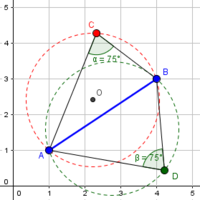I don't have a lot more parameters to give.
I want to get all the points that create an angle of between 50-150 degrees with both A and B.
one other parameter I thought of is that if the distance AB = x,
and O = mid AB,
then the distance AO must be 2x.
that's all the parameters I have;
A,B,dis AB,O,dis AO, angle ACB.
First, now that you're no longer being moderated, we can interact better (and you should be able to edit).
Looking back to what you wrote before I wrote, but I couldn't see yet, I see that you made a huge mistake in the OP -- the given angle is neither BAC nor b, as you wrote, nor ABC as you drew, but ACB, which is at the unknown point rather than one of the known points! In the original problem as you had stated it, C would lie on one of two rays from B (or A), at the given angle, and we would need to find the equation of each line (and then present it in whatever way would be helpful to you). That is not at all the case in what you really want.
There is an important geometry theorem you need to know, that any angle inscribed in a circle is equal to half the arc it cuts from the circle. A consequence of that is that given the angle at C, you know that C lies on one of two particular circles through A and B. We can find the centers of those circles. But I'm going to hold off on that.
We still need to figure out what you really want to find. You can't find, all at once, ALL possible locations of C, though that is still what you are claiming to want. You need to decide what you are going to do with the result, in order to have any idea what the output of the function you want to write would be.
Now, what you just said in post #9 doesn't make much sense. If you know the locations of A and B, then the distance AB and the location of the midpoint O are easily determined -- they are not additional information. And the distance AO would not be 2x; it would be x/2, and again would tell us nothing new about the location of C. Either I am totally misunderstanding what you want to do, or you have not thought about the reality of your goal, such as by drawing a figure.
Here is what it looks like:

Point C can lie anywhere on the part of the red circle above AB, or any part of the green circle below AB. (My O is the center of the red circle.)
Now, in practice, you surely want to choose one of those possible points. How do you plan to do that? That will be part of what we need in order to specify the actual requirements for whatever formula or procedure we come up with.
You've hinted at the context of your question (something about maps?); when you ask a question, it's really valuable if you can explain the context fully enough to make it clear what you will be doing with the result. It's very common for people to think that by removing a question from its context they are making it easier for helpers, but the truth is the opposite. The more you tell us, the more quickly we can discern your needs and help appropriately.

